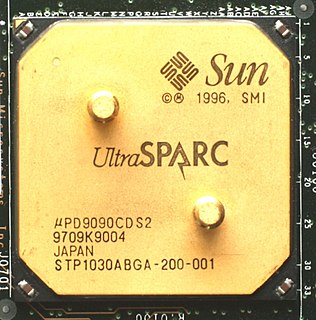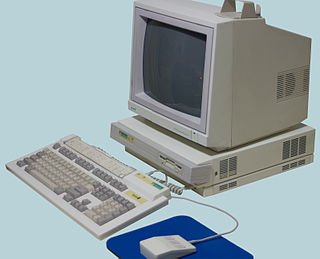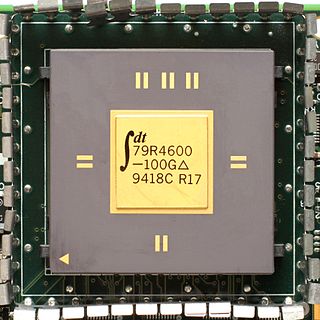This page is based on this
Wikipedia article Text is available under the
CC BY-SA 4.0 license; additional terms may apply.
Images, videos and audio are available under their respective licenses.

A reduced instruction set computer, or RISC, is one whose instruction set architecture (ISA) allows it to have fewer cycles per instruction (CPI) than a complex instruction set computer (CISC). Various suggestions have been made regarding a precise definition of RISC, but the general concept is that such a computer has a small set of simple and general instructions, rather than a large set of complex and specialized instructions. Another common RISC trait is their load/store architecture, in which memory is accessed through specific instructions rather than as a part of most instructions.

The Acorn Archimedes is a family of personal computers designed by Acorn Computers Ltd in Cambridge (England) and sold in the late-1980s to mid-1990s, Acorn's first general-purpose home computer based on its own ARM architecture. The first Archimedes was launched in 1987.
The Intel i860 was a RISC microprocessor design introduced by Intel in 1989. It was one of Intel's first attempts at an entirely new, high-end instruction set architecture since the failed Intel iAPX 432 from the 1980s. It was released with considerable fanfare, slightly obscuring the earlier Intel i960, which was successful in some niches of embedded systems, and which many considered to be a better design. The i860 never achieved commercial success and the project was terminated in the mid-1990s.

Quantum Effect Devices (QED) was a microprocessor design company incorporated in 1991 as Quantum Effect Design. It was based in Palo Alto, California.
The Advanced Computing Environment (ACE) was defined by an industry consortium in the early 1990s to be the next generation commodity computing platform, the successor to personal computers based on Intel's 32-bit instruction set architecture. The effort found little support in the market and dissolved due to a lack of sales and infighting within the group.

Windows NT 3.1 is an operating system that was produced by Microsoft as part of the Windows NT family of operating systems. It was released on July 27, 1993.
Berkeley RISC is one of two seminal research projects into RISC-based microprocessor design taking place under ARPA's VLSI project. RISC was led by David Patterson at the University of California, Berkeley between 1980 and 1984.
The NEC RISCstation was a line of computer workstations made by NEC in the mid-1990s, based on MIPS RISC microprocessors and designed to run Microsoft Windows NT. A series of nearly identical machines were also sold by NEC in headless configuration as the RISCserver series, and were intended for use as Windows NT workgroup servers.
Advanced RISC Computing (ARC) is a specification promulgated by a defunct consortium of computer manufacturers, setting forth a standard MIPS RISC-based computer hardware and firmware environment.
The Jazz computer architecture was a motherboard and chipset design originally developed by Microsoft for use in developing Windows NT. The design was eventually used as the basis for most MIPS-based Windows NT systems.
The M6100 PICA is a system logic chipset designed by Acer Laboratories introduced in 1993. PICA stands for Performance-enhanced Input-output and CPU Architecture. It was based on the Jazz architecture developed by Microsoft and supported the MIPS Technologies R4000 or R4400 microprocessors. The chipset was designed for computers that run Windows NT, and therefore used ARC firmware to boot Windows NT. The chipset consisted of six chips: a CPU and secondary cache controller, a buffer, a I/O cache and bus controller, a memory controller, and two data buffers.
Hombre is a RISC chipset for the Amiga, designed by Commodore, which was intended as the basis of its next generation game machine called CD64 and a 3D accelerator PCI card. Hombre was canceled along with the bankruptcy of Commodore International.
The R4200 is a microprocessor designed by MIPS Technologies, Inc. (MTI) that implemented the MIPS III instruction set architecture (ISA). It was also known as the VRX during development. The microprocessor was licensed to NEC, and the company fabricated and marketed it as the VR4200. The first VR4200, an 80 MHz part, was introduced in 1993. A faster 100 MHz part became available in 1994. The R4200 was developed specifically for low-power Windows NT computers such as personal computers and laptops. MTI claimed the microprocessor's integer performance was greater than that of a high-end Intel i486 and 80% of a P5-variant Pentium microprocessor. The R4200 ultimately did not see any use in personal computers and was repositioned as an embedded microprocessor that competed with the R4600. The R4300i variant was used in the widely popular Nintendo 64 video game console.

The R4600, code-named "Orion", is a microprocessor developed by Quantum Effect Design (QED) that implemented the MIPS III instruction set architecture (ISA). As QED was a design firm that did not fabricate or sell their designs, the R4600 was first licensed to Integrated Device Technology (IDT), and later to Toshiba and then NKK. These companies fabricated the microprocessor and marketed it. The R4600 was designed as a low-end workstation or high-end embedded microprocessor. Users included Silicon Graphics, Inc. (SGI) for their Indy workstation and DeskStation Technology for their Windows NT workstations. The R4600 was instrumental in making the Indy successful by providing good integer performance at a competitive price. In embedded systems, prominent users included Cisco Systems in their network routers and Canon in their printers.
Since 1985, numerous processors implementing some version of the MIPS architecture have been designed and widely used.





